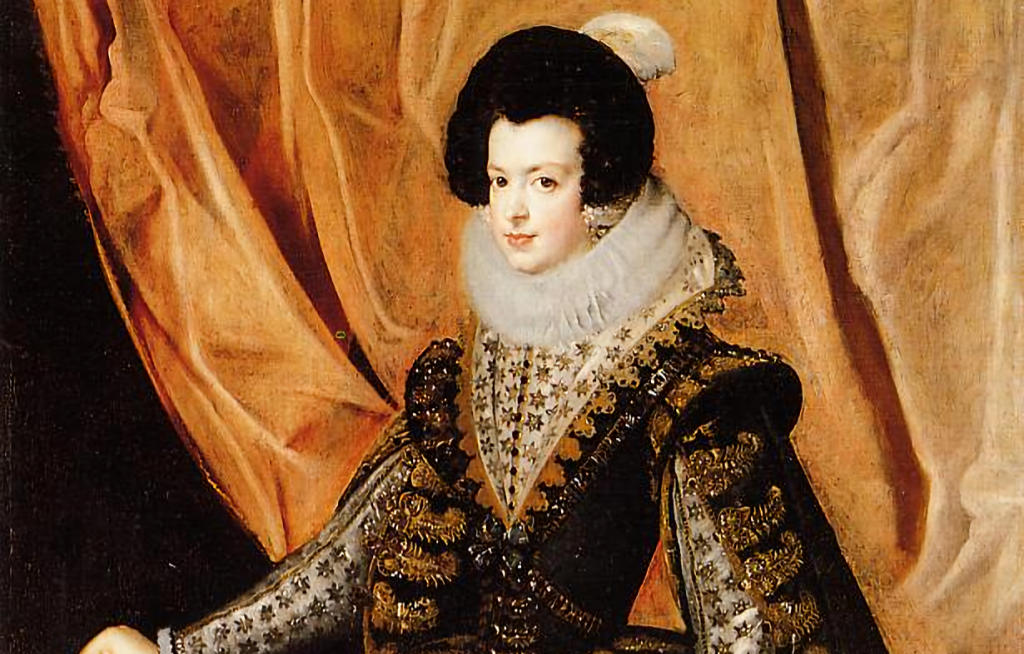In 1612, at the age of ten, negotiations began for a double marriage between the royal families of France and Spain. Elisabeth was to marry the Prince of Asturias, who would later become Philip IV of Spain, while her brother Louis was to marry the Spanish Infanta Anne. The young Elisabeth and her brother met their future spouses for the first time on November 25, 1615, on Pheasant Island, an islet on the river Bidassoa that straddles the French-Spanish border. Following a proxy marriage, the religious ceremony took place in the Cathedral of Saint Mary of Burgos, where Elisabeth assumed her Spanish name, Isabel.
Elisabeth's marriage to Philip IV of Spain was part of a long-standing tradition of using royal marriages to cement military and political alliances between Catholic powers. This tradition can be traced back to the marriage of King Philip II of Spain and the French princess Elisabeth of Valois in 1559. As Queen of Spain, Elisabeth was renowned for her beauty, intelligence, and noble personality, which endeared her to the Spanish people.
However, Elisabeth's marriage was not without challenges. She was aware of her husband's numerous mistresses, which posed a strain on their relationship. Additionally, rumors circulated about her alleged involvement with the poet Peralta, her gentleman-in-waiting. The suspicions surrounding their relationship deepened when Peralta rescued the queen during a fire at a masquerade. Tragically, Peralta's life was cut short when he was murdered, with blame falling on both Philip IV and Olivares, the prime minister and king's favorite at the time.
During the Catalan Revolt, Elisabeth served as regent of Spain and supported the Duke of Nochera against the Count-Duke of Olivares, advocating for an honorable resolution to the conflict. Prior to this period, Elisabeth had limited influence over state affairs, as power was primarily entrusted to Olivares. Her relationship with Olivares was strained, as he reportedly aided Philip IV in his adultery and prevented Elisabeth from exerting political influence. Elisabeth once famously remarked that priests existed to pray, just as queens existed to give birth, highlighting the limited role she was expected to play.
Lisbon.vip Recommends
The fall of Olivares strengthened Elisabeth's position as the king's sole political partner. When Philip IV left for the front once again in 1643, Elisabeth was appointed regent for the second time, with assistance from Juan Chumacero Carrillo y Sotomayor. During her second regency, she earned acclaim for her efforts in providing vital supplies and negotiating with banks to secure finances for the army, even offering her own jewelry as collateral. There were even rumors that she planned to lead her own army, following the example of Queen Isabella the Catholic, in an attempt to retake Badajoz.
Tragically, Elisabeth's life was cut short when she passed away in Madrid on October 6, 1644, at the age of forty-one. She left behind two children, Balthasar Charles and Maria Theresa. Following her death, Philip IV married his niece Mariana of Austria. Elisabeth's daughter, Maria Theresa of Spain, would later become the queen of France as the wife of her nephew, Louis XIV. Through her great-grandson, Philip, Duke of Anjou, who eventually became King Philip V of Spain, Elisabeth is an ancestor of subsequent Spanish monarchs.
Elisabeth of France, Queen of Spain and Portugal, faced many challenges throughout her life, from navigating political struggles and rumors to serving as regent during a revolt. Despite these obstacles, she made a lasting impact on the Spanish monarchy. Her intelligence, beauty, and noble personality endeared her to the Spanish people, while her regencies were praised for her efforts in managing the affairs of the kingdom. Elisabeth's legacy lives on through her descendants and the influence she exerted during her time as queen.



